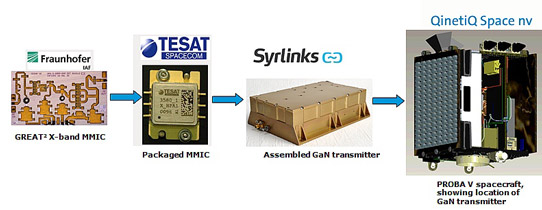- News
26 June 2015
GREAT2 GaN transmitter completes second year aboard ESA's Proba-V satellite as industrial prototypes complete testing
What is decribed as the first European-made device based on gallium nitride (GaN) to be sent into space has completed its second year of operations. Hosted by the European Space Agency (ESA) on its Earth-observing Proba-V mini-satellite in 2013 as a test prototype, the transmitter is currently used routinely to return mission imagery to the ground.
"The X-band transmitter in question incorporates an experimental gallium nitride (GaN) amplifier," says Andrew Barnes, overseeing ESA's work in GaN. "It is still working seamlessly today after two years in orbit, showing no drift in performance," he adds.
The GaN-based transmitter is used to downlink data to Proba-V's Kiruna ground station – in the Swedish Arctic – once per orbit for a week at a time, alternating with a second transmitter using a conventional gallium arsenide (GaAs) amplifier.
With its data coming down at a standard rate of 42.22Mb/s during each approximately 12 minute pass, the cubic-metre-sized Proba-V builds up a complete picture of all the Earth's vegetation cover every two days.
Access to the GaN-based transmitter also increases the operational flexibility of the satellite – in principle its data rate can be boosted to 100Mb/s, while its programmable radio-frequency output power can also be increased as needed, while operating at a lower voltage than its conventional equivalent.
Gallium nitride has been described as the most promising semiconductor since silicon, capable of operating at much higher voltages and temperatures than comparable materials. GaN also possesses inherent resistance against the radiation encountered in space.
"In terms of communications for space, GaN offers a five- to ten-fold increase in communications power, while requiring no additional cooling systems," says Barnes. "Its promise is such that back in 2008 ESA launched the 'GaN Reliability Enhancement and Technology Transfer Initiative' (GREAT2), bringing together leading universities, research institutes and industry to develop space-compatible production processes for making GaN microwave power transistors and integrated circuits," he adds.
"With GREAT2, ESA has come in at an early stage of industrialization to ensure that the resulting products meet the demanding requirements of space use, such as resistance to shock and temperature extremes, as well as continuous operations for years at a time," continues Barnes.

Picture: GaN amplifier supply chain for Proba-V.
The GREAT2 partners include United Monolithic Semiconductors (UMS) based in Germany and France, responsible for the industrial foundry used for manufacturing GaN products.
Proba-V's GaN-based X-band transmitter was an early prototype result from GREAT2, seizing a chance to have an early test of the technology in orbit. The GaN amplifier was incorporated into Proba-V's existing communication system by Syrlinks in France. Since then, while the transmitter has been proving its worth in space, the first industrial prototypes have successfully completed their testing for reliability and robustness.
"As a result of GREAT2 we were able to place the UMS GaN manufacturing process onto the European Preferred Parts List of the European Space Components Coordination – a list of recommended parts for space missions – in 2012," says Barnes. "This was two years earlier than originally planned," he adds. "This was along with obtaining early flight heritage on Proba-V, and the two achievements together have lent confidence to other ESA projects to make use of the technology."
ESA's Biomass mission – an Earth-observing satellite to track global forest biomass – is now planning to use European GaN technology to produce mission-critical solid-state power amplifiers for its P-band synthetic aperture radar. "Work is currently ongoing to qualify high-power GaN power transistors assembled in hermetic packages for the Biomass mission," Barnes reports. "Beyond that, our long-term goal is to make space-qualified hermetically packaged GaN transistors commercially available on the open market, which would be a first for Europe."


